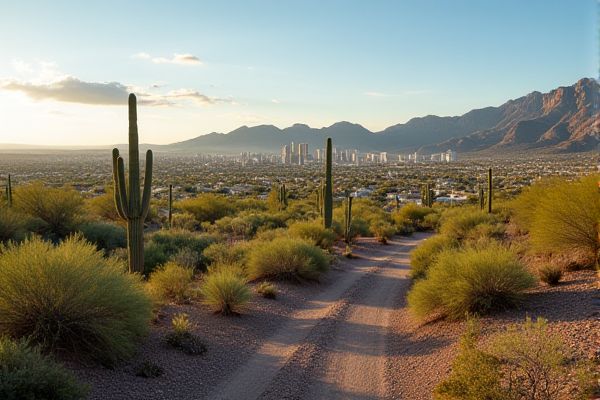
Transportation and commuting in Arizona: Diverse transportation options available. Extensive highway network. Limited public transit coverage. High car dependency. Seasonal traffic variations. Bike-friendly cities. Ride-sharing services accessible. Regional airports serve cities. Park-and-ride facilities. HOV lanes during peak times.
Diverse transportation options available.
Arizona provides a wide array of transportation options to accommodate the diverse needs of its residents and visitors. The state boasts rideshare services like Uber and Lyft, as well as local platforms, making it easy to navigate cities without a personal vehicle. Additionally, the extensive public transit systems include buses, light rail, and streetcars, particularly in urban centers such as Phoenix and Tucson. Bike-sharing programs offer eco-friendly travel alternatives, while traditional car rentals and car-sharing services provide flexibility for longer journeys. Transportation accessibility is also a priority, with services tailored for individuals with disabilities. For those traveling between cities, options such as intercity bus services like Greyhound and rail connections via Amtrak are available, enhancing regional connectivity. Moreover, free local shuttle services and paratransit options cater to a wide range of travel needs. Explore more about these options at Hastings and Hastings, where you can find comprehensive details on Arizona's transportation infrastructure.
Extensive highway network.
The Arizona Department of Transportation (ADOT) manages an extensive highway network, providing real-time road conditions, access to highway cameras, and information on crashes, roadwork, closures, and weather advisories through the AZ511 system, which can be accessed via the web, mobile app, or by calling 511.
Limited public transit coverage.
Arizona's public transportation system, while available, is not extensive, particularly lacking a comprehensive subway system and limited to buses, light rail, and train services that do not cover all areas evenly. There are significant gaps in rural and some urban regions. For more details on navigating these transportation challenges, you can visit the Arizona Travel Guide on a reliable website that offers insights and tips on getting to and around the state.
High car dependency.
Arizona, particularly the Phoenix Metropolitan Area, is highly car-dependent due to large open spaces, high temperatures, and a lack of a well-integrated public transportation network, leading to significant external costs such as emissions, congestion, and road expenditures. Efforts to reduce car dependency include introducing alternative transport modes, such as Orbit buses, metro lines, and bike-sharing programs, although these initiatives face challenges like COVID-related delays and inconsistent public transport services. For more insights into this issue, you can explore the detailed study on Car Dependency and Alternative Travel Behavior at the ASU Campus. These efforts are crucial for building a sustainable transportation ecosystem in the region.
Seasonal traffic variations.
In Arizona, seasonal traffic variations are significant, particularly around tourist destinations like Sedona and Flagstaff. During weekends and peak tourist seasons (March to October), traffic congestion is common, especially on highways like I-17 and I-40, with increased travel times and potential for slow-moving traffic due to both tourist influx and winter weather conditions. For more detailed updates and information on current road conditions, you can visit the Flagstaff Traffic and Road Conditions website.
Bike-friendly cities.
Arizona's most bike-friendly cities include Tucson, Tempe, Chandler, Gilbert, and Phoenix, with these cities offering a mix of recreational paths, off-road biking tracks, and urban bike lanes. This combination significantly influences real estate choices and housing trends due to their bikeability features. For more detailed information on the bike-friendly cities in Arizona, you can visit Real Connect, which highlights the integration of cycling infrastructure into urban planning. These amenities help foster an active lifestyle, making the cities not only environmentally friendly but also more appealing to potential homebuyers.
Ride-sharing services accessible.
Lyft and other ride-sharing services such as Uber, Didi, and Ola are widely available in Phoenix, Arizona, offering convenient and affordable rides across the city, including to and from airports. These services adjust fares based on demand and include additional surcharges for tolls and other fees. To learn more about their services, you can visit the site for Lyft in Phoenix for detailed information.
Regional airports serve cities.
Regional airports in Arizona, including Tucson International Airport (TUS), Phoenix-Mesa Gateway Airport (AZA), Flagstaff Pulliam Airport (FLG), and Yuma International Airport (YUM), serve numerous cities and offer regional flights. Major airlines like American Airlines, Southwest Airlines, and Allegiant Air operate from these airports, providing essential transportation links to cities such as Tucson, Mesa, Flagstaff, and Yuma. Additionally, these airports offer an array of ground transportation options, including public buses, shuttles, and taxis. For more information, head over to the GetByBus website to explore detailed guides on these Arizona transport hubs.
Park-and-ride facilities.
Park-and-ride facilities in Arizona, such as those for the Arizona State Fair, offer convenience, cost savings, reduced stress, environmental benefits, and enhanced safety by allowing attendees to park at designated locations like Phoenix College or the State Capitol and take a shuttle directly to the event, avoiding traffic and parking hassles. These facilities promote a more efficient, affordable, and sustainable commuting experience.
HOV lanes during peak times.
HOV lanes in Arizona serve as a crucial component in managing traffic during peak hours. From 6 a.m. to 9 a.m. and 3 p.m. to 7 p.m., Monday through Friday, these lanes are reserved for vehicles with two or more occupants, motorcycles, public transportation vehicles, and alternative fuel vehicles bearing specific license plates. During non-peak hours, HOV lanes in Arizona are open to all vehicles without any restrictions. This system helps to efficiently manage traffic flow and reduce congestion on busy roads, improving commute times for those who qualify to use the lanes during restricted hours.
